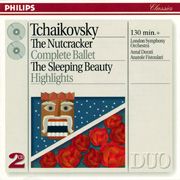
Tchaikovsky: The Nutcracker / The Sleeping Beauty
Royal Concertgebouw Orchestra
London Symphony Orchestra
1994: Philips Classics/Duo 442 562-2
CD 1
The Nutcracker, Op. 71
Royal Concertgebouw Orchestra, Antal Dorati conducting
Boys’ Choir of St Bavo Cathedral, Haarlem (Chorus master: Jan Valkestijn)
Act I
Tableau I
Tableau II
Act II
Tableau III
CD 2
Tableau III (conclusion)
The Sleeping Beauty, Op. 66 (Highlights)
London Symphony Orchestra, Anatole Fistoulari conducting
Hugh Maguire, violin; Kenneth Heat, cello
I think the Nutcracker Suite contains some of the most beautiful music there is, and I’m not ashamed to say so. In all my decades I have never tired of hearing the “Waltz of the Flowers,” the exquisite “Coffee (Arabian Dance),” the “March,” and, believe it or not, even the ubiquitous “Dance of the Sugar-Plum Fairy.” And, to this day, I perk up and become a child again upon hearing the first few notes of the “Overture.” (Granted, it helps that I am almost never exposed to horrendous and cheesy adaptations of the pieces and am instead hearing fully legitimate orchestral performances.) I also particularly love the orchestration of the magnificently effective sequence of string-section runs that first happen midway through the piece—all the more thrilling in well-recorded stereo which allows the runs to seemingly whip around the listen’s head like a whirlwind of snow.
Comments © 2017 Mark Ellis Walker, except as noted, and no claim is made to the images and quoted lyrics.